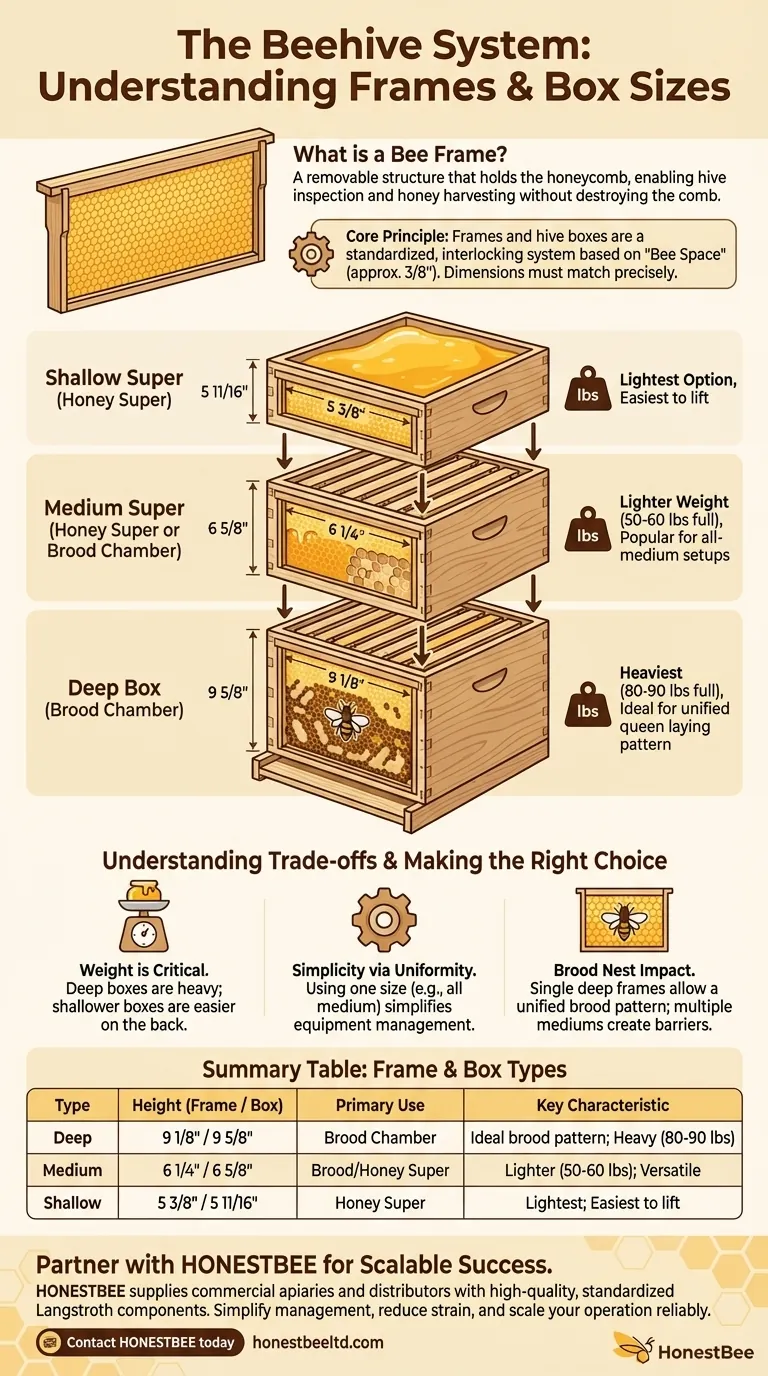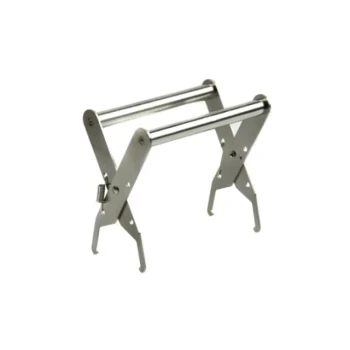At its core, a bee frame is a removable structure that holds the honeycomb within a beehive. It is the single most important innovation in modern beekeeping, allowing for hive inspection and honey harvesting without destroying the colony's comb. The size of the frame—deep, medium, or shallow—is rigidly dictated by the size of the hive box it is designed to fit inside.
The central principle to understand is that bee frames and hive boxes are a standardized, interlocking system. A frame’s purpose is to provide a structured, removable foundation for comb, and its dimensions must precisely match its corresponding box for the entire hive to function correctly.

The Purpose of the Bee Frame
Before modern hives, beekeepers used skeps or boxes where bees built comb attached directly to the walls. To inspect the hive or harvest honey, this comb had to be cut out, a destructive and disruptive process. The removable frame solved this entirely.
A Removable Structure for Comb
The frame provides a "scaffold" that bees use to build their wax comb. Because the frame can be lifted out, a beekeeper can inspect the queen's egg-laying pattern, check for pests and diseases, and assess food stores with minimal disturbance to the colony.
Guiding the Bees' Construction
Frames, especially when fitted with a sheet of foundation (a wax or plastic starter sheet), guide the bees to build straight, orderly comb. This prevents them from building "cross comb" that connects multiple frames, which would make them impossible to remove.
Containing the Colony's Resources
Within the comb held by these frames, the bees organize their entire world. This includes raising young bees (brood), storing pollen and nectar, and curing honey. Each frame is a slice of the colony's life and resources.
Matching Frames to Hive Boxes: A System of Standards
The Langstroth hive, the most common type used today, is built on a principle called "bee space." This precise gap (about 3/8 of an inch) is left around each frame, preventing bees from gluing them to the box walls. This only works when the frame size correctly matches the box size.
Deep Frames for Deep Boxes
A deep frame (9 1/8" tall) is designed exclusively for a deep hive box (9 5/8" tall). This combination is most often used for the brood chamber, the area where the queen lays her eggs and the colony raises its young. The large, uninterrupted comb surface is ideal for the queen's laying pattern.
Medium Frames for Medium Boxes
A medium frame (6 1/4" tall) fits inside a medium box (6 5/8" tall). These are commonly used as honey supers—the boxes stacked on top of the brood chamber for honey storage. They are significantly lighter than deep boxes when full of honey.
Shallow Frames for Shallow Boxes
A shallow frame (5 3/8" tall) fits a shallow box (5 11/16" tall). Like mediums, these are almost exclusively used for honey supers. Their primary advantage is being the lightest option available, making them easier to lift when full.
Understanding the Trade-offs
Choosing a system is about balancing bee biology with the beekeeper's physical ability and management style. The equipment is not interchangeable, so your initial choice has long-term implications.
The Critical Factor: Weight
A deep box filled with honey can weigh 80-90 pounds, which is a significant challenge for many people to lift. A full medium box weighs around 50-60 pounds, and a shallow is even lighter. This is often the single most important factor when choosing equipment.
Hive Configuration and Simplicity
Some beekeepers simplify their operation by using only one size—typically all medium boxes—for both the brood chamber and honey supers. This means you only need one size of frame and foundation, making equipment management much easier. The downside is that it takes two medium boxes to approximate the brood space of one deep box.
Impact on the Brood Nest
While using two medium boxes for brood works well, the wooden bars of the frames create a horizontal barrier in the middle of the nest. A single deep frame allows the queen to create a large, unified brood pattern that more closely mimics what bees do in nature.
Making the Right Choice for Your Hive
Your choice of box and frame size determines how you will manage your bees for years to come. Consider your goals and physical limitations before you invest.
- If your primary focus is a traditional setup that mimics the bees' natural preference: Use one or two deep boxes for the brood chamber and medium or shallow boxes for honey supers.
- If your primary focus is minimizing heavy lifting and simplifying equipment: Use all medium boxes for both the brood chamber and honey supers.
- If your primary focus is having the lightest possible boxes of honey to harvest: Use shallow boxes for your honey supers above a deep or medium brood chamber.
Ultimately, understanding that frames and boxes are a matched system is the first step to building a functional, manageable beehive.
Summary Table:
| Frame & Box Type | Height (Frame / Box) | Primary Use | Key Characteristic |
|---|---|---|---|
| Deep | 9 1/8" / 9 5/8" | Brood Chamber | Ideal for queen's laying pattern; heavy when full (80-90 lbs) |
| Medium | 6 1/4" / 6 5/8" | Brood Chamber or Honey Super | Lighter weight (50-60 lbs); popular for all-medium setups |
| Shallow | 5 3/8" / 5 11/16" | Honey Super | Lightest option; easiest to lift when full of honey |
Ready to Build Your Ideal Hive System?
Choosing the right frames and boxes is the foundation of a successful apiary. HONESTBEE supplies commercial apiaries and beekeeping equipment distributors with the high-quality, standardized components needed for efficient, scalable operations. We provide the durable frames and boxes that form the backbone of the Langstroth system.
Let us help you optimize your setup:
- Simplify your equipment management with consistent, high-quality supplies.
- Reduce physical strain by selecting the right box sizes for your needs.
- Scale your operation with reliable wholesale-focused supply chains.
Contact HONESTBEE today to discuss your beekeeping supply needs and get a quote tailored for commercial success.
Visual Guide

Related Products
- HONESTBEE Wired and Assembled Wooden Bee Frames Foundation for a Thriving Hive
- Plastic Bee Frame Beekeeping Hive Frames for Wholesale
- Assembled Wooden Bee Frames with Beeswax Foundation Ready to Use by HONESTBEE
- Assembled Wooden Bee Frames with Plastic Foundation for Durability and Convenience by HONESTBEE
- 7 x Auto Bee Flow Hive Frames Plastic Beekeeping Hive Box Supplies
People Also Ask
- How long do bee frames last? A Guide to Lifespan and Replacement for Healthy Hives
- Can I reuse old frames? A practical guide to saving money and reducing waste
- Can old bee frames be reused? Weighing the Risks vs. Rewards for Your Hive
- How do wooden frames perform during honey extraction? Superior Rigidity for a Smoother Harvest
- How many frames fit in a 10 frame hive? A Guide to Maximizing Your Hive's Potential



















